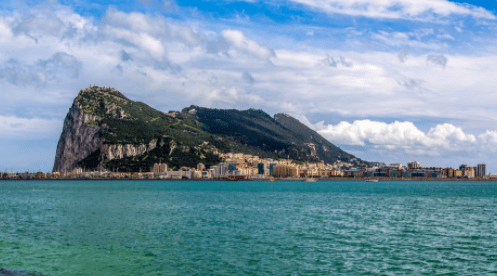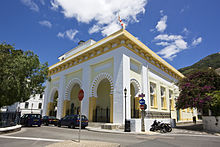Gibraltar is a British Overseas Territory located at the southern tip of the Iberian Peninsula. It has an area of 6.7 km2 (2.6 sq mi) and is bordered to the north by Spain. The landscape is dominated by the Rock of Gibraltar at the foot of which is a densely populated town area, home to over 32,000 people, primarily Gibraltarians.
In 1704, Anglo-Dutch forces captured Gibraltar from Spain during the War of the Spanish Succession on behalf of the Habsburg claim to the Spanish throne. The territory was ceded to Great Britain in perpetuity under the Treaty of Utrecht in 1713. During the Napoleonic Wars and World War II it was an important base for the Royal Navy as it controlled the entrance and exit to the Mediterranean Sea, the Strait of Gibraltar, which is only 14.3 km (8.9 mi) wide at this naval choke point. It remains strategically important, with half the world’s seaborne trade passing through the strait. Today Gibraltar’s economy is based largely on tourism, online gambling, financial services and bunkering.
The sovereignty of Gibraltar is a point of contention in Anglo-Spanish relations because Spain asserts a claim to the territory. Gibraltarians rejected proposals for Spanish sovereignty in a 1967 referendum and, in a 2002 referendum, the idea of shared sovereignty was also rejected.
The official language of Gibraltar is English and is used by the government and in schools. Most locals are bilingual, also speaking Spanish. However, because of the varied mix of ethnic groups which reside there, other languages are also spoken on the Rock. Berber and Arabic are spoken by the Moroccan community, as are Hindi and Sindhi by the Indian community. Maltese is spoken by some families of Maltese descent.
Gibraltarians often converse in Llanito , a vernacular unique to Gibraltar. It is based on Andalusian Spanish with a strong mixture of British English and elements from languages such as Maltese, Portuguese, Genoese Italian and Haketia . Llanito also often involves code-switching to English and Spanish.
Gibraltarians often call themselves Llanitos.
Following 2012 census, approximately 72.1% of Gibraltarians are Roman Catholics. The 16th century Saint Mary the Crowned is the cathedral church of the Roman Catholic Diocese of Gibraltar, and also the oldest Catholic church in the territory. Other Christian denominations include the Church of England (7.7%), whose Cathedral of the Holy Trinity is the cathedral of the Anglican Bishop of Gibraltar in Europe; the Gibraltar Methodist Church, Church of Scotland, various Pentecostal and independent churches mostly influenced by the House Church and Charismatic movements, as well as a Plymouth Brethren congregation. Several of these congregations are represented by the Gibraltar Evangelical Alliance.
There is also a ward of The Church of Jesus Christ of Latter-day Saints, and two congregations of Jehovah’s Witnesses. 7.1% advised that they have no religion.
The third religion in size is Islam (3.6% of the population). There is also an established Hindu population (2%), members of the Baháʼí Faith and a long-established Jewish community, which, at 763 persons, accounts for 2.4% of the population. As a share of the total population, this is the second-largest Jewish population in the world, trailing only Israel. There are four functioning Orthodox synagogues in Gibraltar and several kosher establishments.
The culture of Gibraltar reflects Gibraltarians’ diverse origins. While there are Spanish (mostly from nearby Andalusia) and British influences, the ethnic origins of most Gibraltarians are not confined to these ethnicities. Other ethnicities include Genoese, Maltese, Portuguese, and German. A few other Gibraltar residents are Jewish of Sephardic origin, Moroccan, or Indians. British influence remains strong, with English being the language of government, commerce, education and the media.
Gibraltar’s first sovereignty referendum is celebrated annually on Gibraltar National Day (10 September). It is a public holiday, during which most Gibraltarians dress in their national colours of red and white. Until 2016, the tradition had been to also release 30,000 similarly coloured balloons, which represented the people of Gibraltar. However, this tradition has now been ended because of the threat that it poses to wildlife, particularly marine.The 300th anniversary of Gibraltar’s capture was celebrated in 2004 on Tercentenary Day (4 August), when in recognition of and with thanks for its long association with Gibraltar, the Royal Navy was given the Freedom of the City of Gibraltar and a human chain of Gibraltarians dressed in red, white and blue, linked hands to encircle the Rock. On 4 June 2012, the Gibraltar Diamond Jubilee Flotilla, inspired by the Thames Diamond Jubilee Pageant, celebrated sixty years of the Queen’s reign.
The Gibraltar Broadcasting Corporation operates a television and radio station on UHF, VHF and medium-wave. The radio service is also internet-streamed. Special events and the daily news bulletin are streamed in video. The other local radio service is operated by the British Forces Broadcasting Service which also provides a limited cable television network to HM Forces. The largest and most frequently published newspaper is the Gibraltar Chronicle, Gibraltar’s oldest established daily newspaper and the world’s second-oldest English language newspaper to have been in print continuously with daily editions six days a week. Panorama is published on weekdays, and 7 Days, The New People, and Gibsport are weekly.
Native Gibraltarians have produced some literature of note. The first in fiction was probably Héctor Licudi’s 1929 novel Barbarita, written in Spanish, chronicling the largely autobiographical adventures of a young Gibraltarian man. Throughout the 1940s and 1950s, several anthologies of poetry were published by Leopoldo Sanguinetti, Albert Joseph Patron and Alberto Pizzarello. The 1960s were largely dominated by the theatrical works of Elio Cruz and his two highly acclaimed Spanish language plays La Lola se va pá Londre and Connie con cama camera en el comedor. In the 1990s, the Gibraltarian man-of-letters Mario Arroyo published Profiles (1994), a series of bilingual meditations on love, loneliness and death. Trino Cruz is a bilingual poet originally writing English but now mainly in Spanish, who also translates Maghreb poetry. Of late there have been works by the essayist Mary Chiappe, such as her volume of essays Cabbages and Kings (2006) and by M. G. Sanchez, author of the books Rock Black: Ten Gibraltarian Stories (2008) and Diary of a Victorian Colonial (2009). Mary Chiappe and Sam Benady have also published a series of detective books centred on the character of the nineteenth-century Gibraltarian sleuth Bresciano.
Musicians from Gibraltar include Charles Ramirez, the first guitarist invited to play with the Royal College of Music Orchestra, successful rock bands like Breed 77, Melon Diesel and Taxi, while Gibraltarian bassist Glen Diani played for Irish/British nu metal group One Minute Silence. Albert Hammond had top 10 hits in the UK and US and has written many songs for international artists such as Whitney Houston, Tina Turner and Julio Iglesias.
Gibraltarian cuisine is the result of a long relationship between the Andalusian Spaniards and the British, as well as the many foreigners who made Gibraltar their home over the past three centuries. The culinary influences include those from Malta, Genoa, Portugal, Andalusia and Britain. This marriage of tastes has given Gibraltar an eclectic mix of Mediterranean and British cuisine. Profiteroles, a French choux pastry ball with a sweet filling of whipped cream, is considered to be Gibraltar’s national dish. These are often served after a meal including calentita, a baked bread-like dish made with chickpea flour, water, olive oil, salt and pepper.


